The Mumbai Metropolitan Region Development Authority has undertaken five projects that will change the face of Mumbai. Mainly transport projects, these will not only ease travel in the city, they will give Mumbai a new look. The Mumbai Metro, Mumbai Monorail, Eastern Freeway, Santacruz-Chembur Link Road, and the Sahar Elevated Access Road will be available for the public soon.
1) Mumbai Metro:
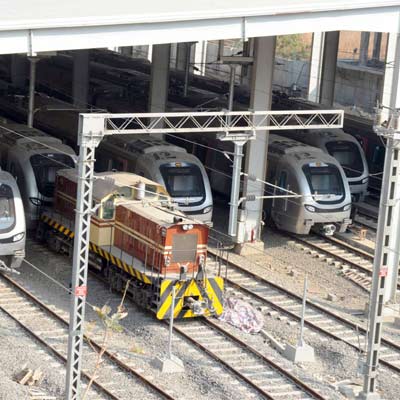 |
| Mumbai Metro |
The Mumbai Metro is a major transport project that falls under Mass Rapid Transit System (MRTS), currently operational in the metro cities of Kolkata, Delhi, and Bangalore. The project is handled by Anil Dhirubhai Ambani Group's Reliance Infrastructure Ltd. along with MMRDA Mumbai Metropolitan Region Development Authority (MMRDA).
The project will be divided into 8 rail lines which will cover a total length of approximately 146 kilometers.
Cost of the project:
The Mumbai Metro will be built in three phases, and the total cost involved is Rs.36000 crore.
The Mumbai Metro will be built in three phases, and the total cost involved is Rs.36000 crore.
Benefits of the project:
-Comfortable & safe journey: The metro trains will be fully air conditioned. They will have an automatic door closing system, which will make sure that there is no risk to life, as opposed to in local trains in which passengers are hanging out of the trains.
-Comfortable & safe journey: The metro trains will be fully air conditioned. They will have an automatic door closing system, which will make sure that there is no risk to life, as opposed to in local trains in which passengers are hanging out of the trains.
-Reduced travel time: The first metro line, Versova - Andheri - Ghatkopar will be covered in 21 mintues as against the present 90 minutes. Similarly, the metro project will substantially reduce the travel time by 50-75%.
-Reduced road traffic: The metros will be made to serve the busiest routes, hence reducing the load on other forms of public and private transport.
-Less pollution: It will reduce vehicular pollution because people will start depending on the metro service more than any other form of transport.
Features of the project:
-Equipped with elevators and escalators: All stations will be equipped with elevators on the both sides of the road. The stations will have escalators in place of stairs.
Features of the project:
-Equipped with elevators and escalators: All stations will be equipped with elevators on the both sides of the road. The stations will have escalators in place of stairs.
-Tactile flooring: A system of textured ground surface indicators will be provided to aide visually impared people.
-Facilities for disabled people: All Coaches of trains will have facilities to accommodate wheel chair, which will be provided by the station if necessary.
-Washrooms: All metro stations will have washrooms and separate toilets will be provided at every station for the physically challenged people.
Ticket Fare:
The ticket fare will be as follows:
The ticket fare will be as follows:
*Rs. 6 upto 3 Kms.
*Rs. 8 between 3 Kms.to 8 Kms.
*Rs. 10 beyond 8 Kms.
*Rs. 8 between 3 Kms.to 8 Kms.
*Rs. 10 beyond 8 Kms.
The Mumbai Metro will have an Automatic Fare Collection System (AFC), with smart cards available for multiple journeys.
Operational timings of the metro rail service:
The trains will ply for 18.5 hours everyday (5.30 am till midnight)
The trains will ply for 18.5 hours everyday (5.30 am till midnight)
Frequency of the trains:
Initially, the frequency of the trains would be 3.5 minutes. This will be further increased over a period of time.
Initially, the frequency of the trains would be 3.5 minutes. This will be further increased over a period of time.
Capacity of the trains:
According to a traffic study conducted by Metro One and the Hong Kong-based traffic consultant MVA Systra, 55,000 people could travel per hour in one direction in up to sixteen trains, with four to six coaches each.
According to a traffic study conducted by Metro One and the Hong Kong-based traffic consultant MVA Systra, 55,000 people could travel per hour in one direction in up to sixteen trains, with four to six coaches each.
The total daily passenger count was hence estimated to be 1.5 million.
The metro project is expected to be complete in 2021, the first line starting its operations in October 2013.
2) Mumbai Monorail:
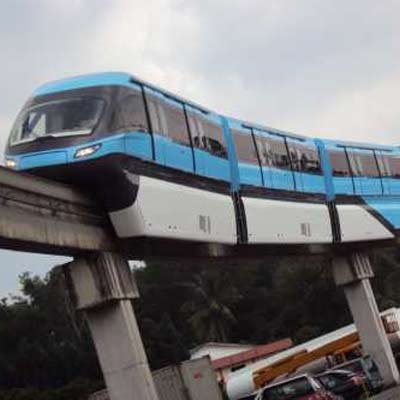 |
| Mumbai Monorail |
The monorail is a rail-based transportation system which is a part of the transport expansion plan of Mumbai.
It is the country’s first monorail which is being implemented by Mumbai Metropolitan Region Development Authority, in association with Larsen & Toubro (L&T) and a Malaysian infrastructure firm Scomi Engineering.
The monorail will have a top speed of 80 kilometres per hour an average speed of 65 kilometres per hour.
Cost of the project:
The complete network of 135 km and 8 lines, built in different phases, will cost around Rs. 202 billion.
The complete network of 135 km and 8 lines, built in different phases, will cost around Rs. 202 billion.
Benefits of the project:
-Easing traffic flow: The monorail, just like the Mumbai metro, will ease the traffic condition and also share the burden of the suburban railway.
-Easing traffic flow: The monorail, just like the Mumbai metro, will ease the traffic condition and also share the burden of the suburban railway.
-Comfortable journey: The monorail cars are fully air-conditioned, hence ensuring a comfortable journey in all weather conditions.
-Green project: The management stated that the monorail would run on electricity and would not use any fossil fuels for operation. The monorail will also save 200 tonnes of Carbon dioxide.
The system is designed to not obstruct much sunlight and not trap excessive emission.
The system is designed to not obstruct much sunlight and not trap excessive emission.
-Reduced noise: The monorail is known to produce sound significantly lower than the 95 decibel, as produced by other modes of transport.
Features of the project:
-Advanced passenger-driver communication
-Advanced passenger-driver communication
-CCTV cameras: This is to ensure safety of the passengers and also to punish defaulters who damage the government property.
-Fire hydrants: In case of fire, these can be used. Safety of the passengers has been given topmost priority, this being one of them to ensure it.
Ticket Fare: The minimum fare is proposed to be Rs. 8 and the maximum Rs. 20.
Operational timings:
The monorail facility will be available from 5 am in the morning till midnight.
The monorail facility will be available from 5 am in the morning till midnight.
Frequency of the trains:
The monorail system has been designed for a 3 minute headway and is designed to carry 125000 passengers per day.
The monorail system has been designed for a 3 minute headway and is designed to carry 125000 passengers per day.
Capacity of the trains:
During peak hours, the estimated number of passengers that can travel is 7,400 with 125,000 passengers per day.
During peak hours, the estimated number of passengers that can travel is 7,400 with 125,000 passengers per day.
The 19.54 km long Chembur-Wadala-Jacob Circle line will be operational from August 2013, the state authorities claim.
3) Eastern Freeway:
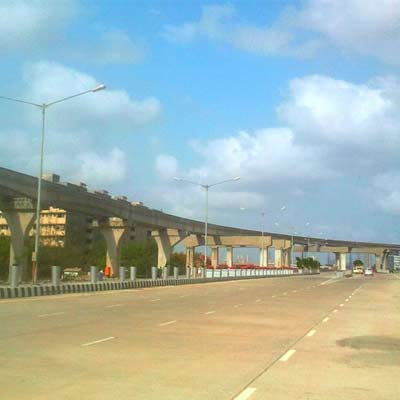 |
| Mumbai Eastern Freeway |
The Mumbai Eastern Freeway is a 16.8 kilometer long highway designed especially for high-speed vehicular traffic constructed between Fort in South Mumbai and Eastern Express Highway in Ghatkopar.
The Eastern Freeway is being built by the Mumbai Metropolitan Region Development Authority, funded by the Central Government.
The contract of this project has been given to Simplex infrastructure.
It will be completed in three phases: the first 12-km-stretch from Fort to Anik depot; the second 5-km-phase from Anik to Panjarpol; and Panjarpol to Mankhurd and then to Ghatkopar on the Eastern Express Highway.
Cost of the project:
This highly beneficial infrastructure project is slated to be made at a cost of around Rs. 8.88 billion.
This highly beneficial infrastructure project is slated to be made at a cost of around Rs. 8.88 billion.
Benefits of the project:
-Less travel time: The Eastern Freeway is designed to cut down travel time between Shivaji Chowk in Chembur and Mumbai CST by 25-30 minutes.
The 20-km distance that takes around 45-60 minutes via Dr. Ambedkar Road will be covered in 20-30 minutes post freeway. The distance will also reduce by 5-6 kilometres.
-Less travel time: The Eastern Freeway is designed to cut down travel time between Shivaji Chowk in Chembur and Mumbai CST by 25-30 minutes.
The 20-km distance that takes around 45-60 minutes via Dr. Ambedkar Road will be covered in 20-30 minutes post freeway. The distance will also reduce by 5-6 kilometres.
-Relaxed traffic movement: After the construction of the Eastern Freeway, the traffic movement towards Navi Mumbai, Nashik, Pune, etc will experience easy movement as the traffic will be divided.
-Signal-Free stretch: The Eastern Freeway is a signal-free stretch of land that will hugely cut down travel time. It is specially designed for high-speed traffic and this feature aides the process by a great amount.
Features of the project:
-Equipped with seismic arresters: The elevated portion of the Eastern Freeway is equipped with seismic arresters that can tolerate an earthquake of up to 7.5 Reichter Scale.
-Equipped with seismic arresters: The elevated portion of the Eastern Freeway is equipped with seismic arresters that can tolerate an earthquake of up to 7.5 Reichter Scale.
-Allows movement of heavy vehicles: The Freeway is specially designed for multi-axle vehicles.
-Equipped with steel crash barriers: These have been installed to stop vehicles from going into the opposite lanes during the time of accidents.
-Twin tunnels: This project will consist of constructing two 500 m long tunnels at the start of the Bhabha Atomic Research Centre (BARC) mountain.
4) Santacruz - Chembur Link Road:
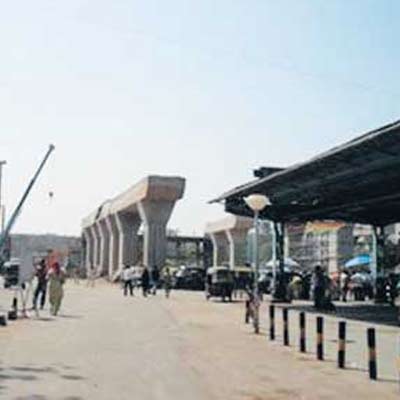 |
| Santacruz- Chembur Link Road |
The north-south commute in the city has been given a lot of importance, since the city of Mumbai is geographically vertical.
The Santacruz - Chembur Link Road aims at improving the east-west connectivity of the city.
It is a 6.45 kilometre long road running from Dr. Hans Bhugra junction in Santacruz East and running to the East skirting Vidyanagari Campus (Mumbai University at Kalina) on its south and meeting Lal Bahadur Shastri (LBS) Marg after crossing Meethi River Bridge.
It is a 6.45 kilometre long road running from Dr. Hans Bhugra junction in Santacruz East and running to the East skirting Vidyanagari Campus (Mumbai University at Kalina) on its south and meeting Lal Bahadur Shastri (LBS) Marg after crossing Meethi River Bridge.
It is a six-lane road and also consists of India's first double decker flyover.
The project is being implemented by the Mumbai Metropolitan Region Development Authority (MMRDA).
Cost of the project:
SCLR is under the World Bank-funded Mumbai Urban Transport Project (MUTP) and is being constructed at a cost of Rs. 435 crore.
SCLR is under the World Bank-funded Mumbai Urban Transport Project (MUTP) and is being constructed at a cost of Rs. 435 crore.
Benefits of the project:
-Reduced travel time: Presently, commuters heading towards Navi Mumbai from the Western Suburbs have to take the Jogeshwari-Vikhroli Link Road, the Andheri-Kurla Road or take a detour from Sion. This traveling can take from 90 minutes up to 2 hours. After the Santacruz-Chembur Link Road is built, it will reduce the travel time to only 17 minutes.
-Reduced travel time: Presently, commuters heading towards Navi Mumbai from the Western Suburbs have to take the Jogeshwari-Vikhroli Link Road, the Andheri-Kurla Road or take a detour from Sion. This traveling can take from 90 minutes up to 2 hours. After the Santacruz-Chembur Link Road is built, it will reduce the travel time to only 17 minutes.
-Better connectivity: The Eastern and Western Express Highways, which are busy routes for commercial road transport, will better connected after the construction of this link road.
Features of the project:
-Double decker flyover: The project consist of a double decker flyover with one arm extending to Tilak Nagar Terminus for commuters travelling towards North and South, another to LBS Marg in Kurla West and another to Nehru Nagar in Kurla East.
-Double decker flyover: The project consist of a double decker flyover with one arm extending to Tilak Nagar Terminus for commuters travelling towards North and South, another to LBS Marg in Kurla West and another to Nehru Nagar in Kurla East.
The construction of Santacruz - Chembur Sea Link is likely to be completed by the end of 2013.
5) Sahar Elevated Access Road:
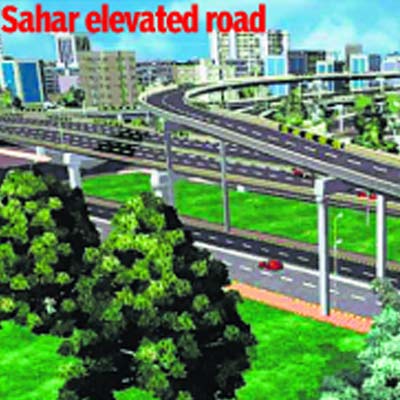 |
| Sahar Elevated Access Road |
Sahar Elevated Access Road is an elevated road that connects the Western Express Highway to the Terminal T2 of Chhatrapati Shivaji International Airport. It is under construction in Mumbai and is undertaken by the Mumbai Metropolitan Region Development Authority.
It is a 3.3 km long access road and includes an underpass for vehicles on the Western Express Highway, a pedestrian subway, underpasses, a tunnel and ramps connecting the highway to the terminal.
The access road has has 4 entry points and 2 exit points.
Cost of the project:
The entire project will cost Rs. 570 crore and will be funded by the Central Government, the government of Maharashtra, the MMRDA and Mumbai International Airport Limited.
The entire project will cost Rs. 570 crore and will be funded by the Central Government, the government of Maharashtra, the MMRDA and Mumbai International Airport Limited.
Benefits of the project:
-Easy commute: Travellers who have to reach the T2 terminal of the Chhatrapati Shivaji International Airport face a lot of congestion as they cross the roads of Andheri. This road eases commute, leading them directly to the T2 terminal from the Western Express Highway.
-Easy commute: Travellers who have to reach the T2 terminal of the Chhatrapati Shivaji International Airport face a lot of congestion as they cross the roads of Andheri. This road eases commute, leading them directly to the T2 terminal from the Western Express Highway.
Features of the project:
-Adjoining tunnel: The project includes a 98-metre-long (322 ft) tunnel which will be built at the junction of the corridor.
-Adjoining tunnel: The project includes a 98-metre-long (322 ft) tunnel which will be built at the junction of the corridor.
The work on Sahar Elevated Road has been delayed by a year is now expected to open to the public by the end of 2013.
This comment has been removed by the author.
ReplyDelete